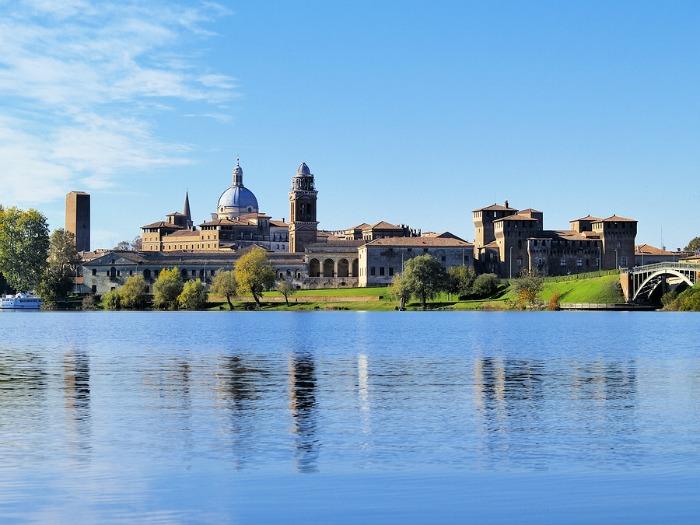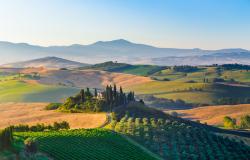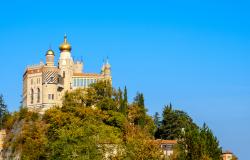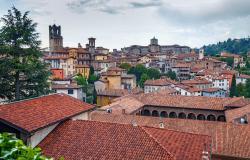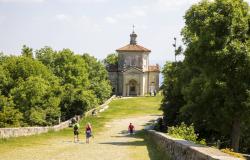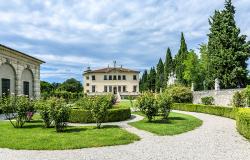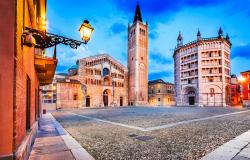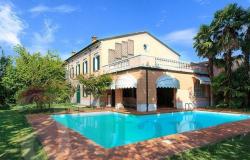If you enter Mantova - Mantua from the north-east, across the bridge over the misty waters that surround it on three sides, the city seems to float like a golden mirage. With its high brick walls, cupolas, towers, miradors, loggias and red-tiled roofs, it is more like a Renaissance architectural fantasy than a living city of the 21st century. Almost an island, and still protected in part by high walls, it may be hot and humid in summer, cold and foggy in winter, but that moodiness makes it one of the most romantic cities in northern Italy.
As you walk along Mantua’s narrow cobbled streets and arcades, under arches and into dead-ends, you will discover grand palaces and churches, hidden squares, internal courtyards, statues in niches; and other small architectural details. No wonder it was once described by the courtier, Castiglioni, as ‘a city in the form of a palace’!

Indeed, it’s difficult to tell where the palaces end and the rest of the city begins. Even the biggest square, Piazza Sordello, was originally part of the Palazzo Ducale. Most of its spectacular monuments were built mainly in the 15th and 16th centuries under the patronage of one ruling family: the Gonzagas.
Founded by the Etruscans and named after an Etruscan divinity, Mantua’s first claim to fame was as the home of the poet Virgil, born nearby in 70BC. His benevolent statue sits in a niche on the Palazzo del Podestà in Piazza del Broletto. It seems to have acquired the status of a saint or a magician.
Later, the city fell under the control of the Canossa (whose palace in Piazza Canossa is guarded by attractive stone dogs) and then Bonacolsi families, both of which left several attractive buildings, before the Gonzaga family (famous as horse breeders and merchants) gained control after a bloody revolt in 1328.
The rise and fall of the house of Gonzaga is a classic tale. Like many nouveaux riches, the Gonzagas built magnificent palaces, employed the most famous artists of the times (from Pisanello to Mantegna, Giulio Romano to Tintoretto and Rubens), got educated, married well and rewrote their own family history!
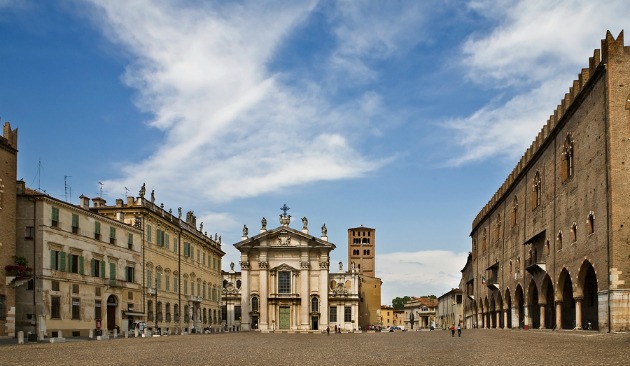
But as the money began to run out, their successors started to sell their art collections to pay the bills. After the city was sacked by soldiers of the Holy Roman Emperor in 1630 and was then ravaged by the plague, the city went into further cultural and economic decline. The last Duke of Gonzaga eventually fled and, in 1707, Mantua fell to Austria, which more or less maintained control until the city became part of a united Italy in 1866. Apart from the odd moment, such as Mozart’s performance at the age of 13 in the charming 18th century Teatro Scientifico in 1769; and Verdi’s choice of Mantua as the setting of his opera Rigoletto, it has been a wealthy little backwater ever since.
At their best, the Gonzagas and their wives (notably Isabella d’Este) were phenomenal patrons, providing an environment in which artists like Mantegna and Giulio Romano produced their finest work. At their worst, they were megalomaniacs. Their major legacies are the Palazzo Ducale and the Palazzo Te, at opposite ends of the town and spectrum.
History
You need every ounce of energy to attack the Palazzo Ducale, a labyrinthine 3-D realisation of an Escher print, which extends over several buildings (incorporating the earlier Palazzo del Capitano built by the unfortunate Bonacolsi and the fortified Castello di San Giorgio), with 15 courtyards, squares and gardens, covering a total area of 34,000 square metres. You have to take a guided tour, partly because of security problems, but also because you’d get lost otherwise.
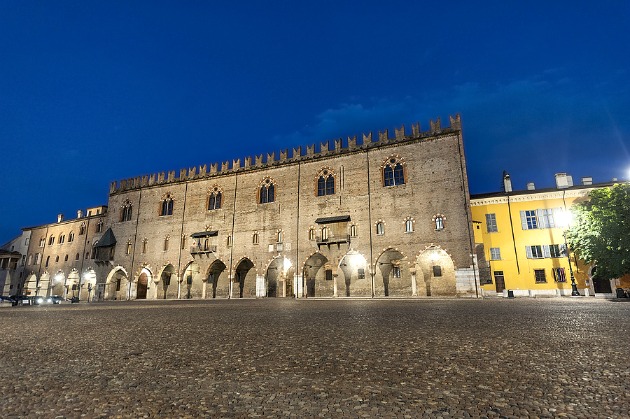
The guides rattle off statistics and facts at you like machine guns as they race you through some of the 500-odd rooms. Most of the moveable contents were sold or sacked centuries ago, but treasures include fragments of a magnificent Pisanello fresco, depicting battle scenes from the Arthurian legends; tapestries woven according to designs by Raphael; and paintings by Tintoretto and Rubens. Horses and chariots race across one ceiling, while zodiac signs decorate another. In one room, a frieze shows parts of horses covered by trompe l’oeil curtains. Apparently, a party trick was to be able to recognize the name of a horse from its body parts. There were hidden passages and doors; and even miniature apartments once thought to have been used to house the family’s much-loved dwarves.

But nothing prepares you for the highlight, approached via a spiral stone ramp (built for horses). The Camera degli Sposi was a meeting room painted by Mantegna from 1465-74 for Ludovico II Gonzaga and his wife Barbara di Brandenburg. The whole room is covered in courtly scenes while people, angels and putti look down from a trompe l’oeil balcony in a blue sky.
Time for Te
After such an onslaught of culture, it must be time to eat and relax. All the local palace employees head for one of the local trattorie with outdoor tables in summer and cosy rooms inside in winter, join them and drink lambrusco wine in ceramic bowls while tasting local specialities such as luccio in salsa con polenta (fresh water pike in a sweet/sour sauce).
If the Palazzo Ducale is the result of centuries of additions and adaptations, with a heavy emphasis on power, the Palazzo Te could not be more different, created on the outskirts of the city on reclaimed marshland as a pleasure palace for horse-riding and summer entertainment. It was built in under 10 years, from 1526-35, by Giulio Romano, a pupil of Raphael, for Federico II Gonzaga and has a lightness and frivolity that is like breath of fresh air. But it turned out to be a suitable place both for Federico’s trysts with his mistress, Isabella Boschetti and for entertaining on a grand scale. It was here that Federico received Emperor Charles V in 1530 and obtained the longed-for title of Duke. High mannerist in design, the palace was as fashionable and bizarre as times would permit.
The building features elaborate architectural jokes and ‘ancient’ grottoes, but to wander through its rooms is to enter a fantasy world. Vast portraits of Federico’s favourite horses decorate one room, while the adjoining Camera di Psiche (Hall of Psyche) is covered in extremely explicit erotic paintings from the Golden Ass by Apuleius.
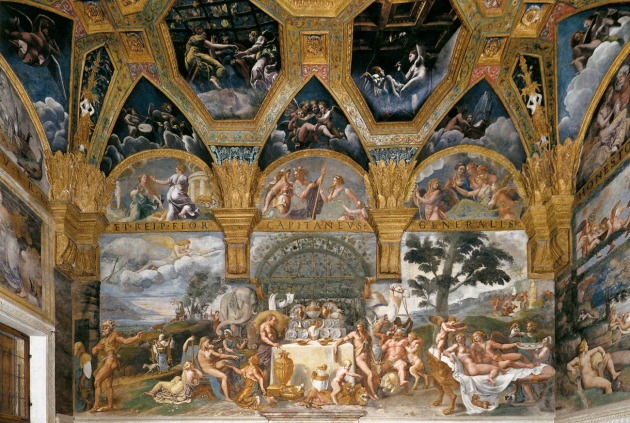
Every room has something of interest, but the wildest and most fantastic of all is the Sala dei Giganti. This beehive shaped room is covered in frescoes depicting the defeat of the Giants, who had besieged Olympus. Over the chimneypiece Giulio depicted the Giants hurtling downwards so that, when the fire was lit, they seemed to be falling into it! The original floor was deliberately uneven to increase the sense of the visitor’s disorientation. The Palazzo Te has many other interesting rooms as well as a fine archaeological collection, but, after the Sala dei Giganti, everything is an anticlimax and mental indigestion means that it’s time to explore other aspects of the city.

Exploring further
On the way back to the centre, you could stop for a coffee at Caffè Roberta on the corner of Via XX Settembre and Via Pescherie. You will be fortified by the coffee and the poem by Gabriele D’Annunzio over the bar:
Nero come la notte - Black as the night
Amaro come il dolore - Bitter as pain
Forte come la passione - Strong as passion
Bruciante come il desiderio - Burning as desire
If the literary aspect attracts you, then you must time your visit to coincide with the annual literary festival in September. The Via Pescherie has a covered stone bridge over the Rio, the picturesque canal that once linked the Lago Superiore to the Lago Inferiore. There used to be lots of fishmongers along this street, but now there is just one, the Pescherie Lanfranchi. The Via Pescherie leads into the Via Orefici, which is full of interesting old-fashioned pharmacies and food shops; and if you continue you will find yourself at the Piazza Concordia, at the backside of the lovely Rotonda of San Lorenzo, a Romanesque church with a circular ground plan, built by Matilde di Canossa in the 11th century.
On the north side of the Rotonda lies the clock tower and the Piazza Erbe, while to the west lies Piazza Mantegna, with the huge Basilica of San Andrea, designed by Alberti (but finished only years later with money raised through a lottery). These two squares are always full of life; and the arcaded streets that fan out from Piazza Mantegna are full of small boutiques and speciality shops, tempting pasticcerie and cafés.

To eat local specialities such as ravioli di zucca (pumpkin ravioli) in Piazza Erbe while watching the food and flower market pack up at lunchtime, is one of the great joys of visiting this city.
For dessert, cross the square to Pasticceria Caravatti and gorge on torta sbrisolona (a cross between shortbread and crumble, made with almonds, sugar, butter and flour) or elvezia (brought by the Austrians and made with almonds, eggs, sugar, butter, rum and chocolate).
There are other palaces and churches of interest; and winter brings a series of concerts in the delightful Teatro Scientifico, but if you want to relax, then its time to go out onto the water, for Mantua’s hinterland boasts the compelling beauty of the River Mincio, with its river side paths and protected natural park. You can take boat excursions from the docks on either side of the Via Legnago, but if you want a different experience, drive 12kms west of Mantua to the weird and wonderful
Sanctuary of the Beata Vergine delle Grazie, full of strange votive offerings, from sculpted breasts to a stuffed crocodile.
Behind the church, a grassy slope leads down to the water, where, in August, you can take a boat trip out among the reeds to see the lotus flowers in bloom. Truly, it is a magical way to end your stay!
